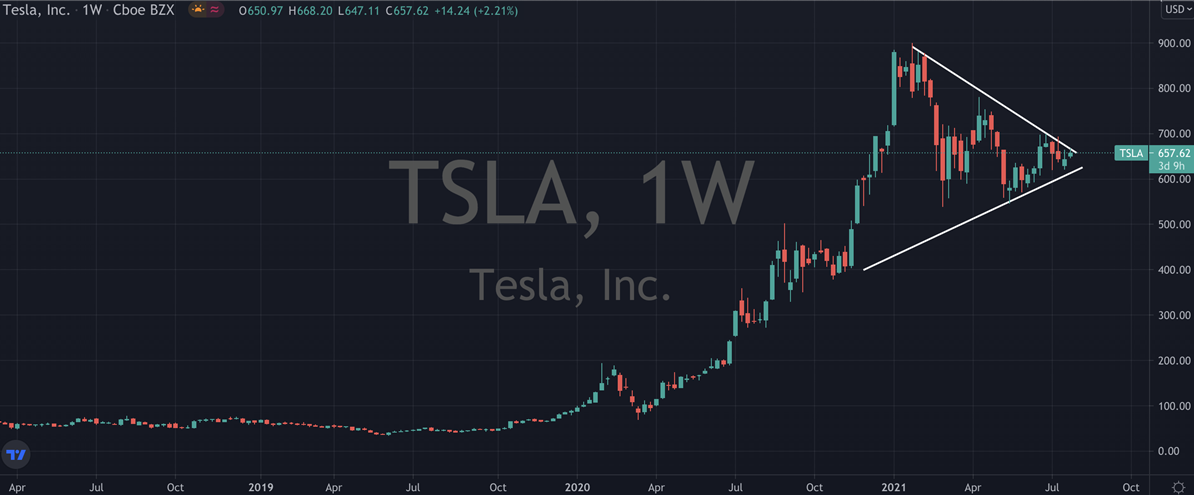Tesla’s (NASDAQ:) Q2 earnings were released after the bell rang to end Monday’s session, and gave Main Street and Wall Street alike a much-awaited look under the hood. Compared to their dizzying performance in 2020, shares of the electric car maker have been sluggish at best in the first half of 2021. They set a handful of fresh highs in the opening weeks of the year before falling afoul of the rising interest rate environment that took hold in late February. This sent them down 40% but if you take into account their recent performance, the outlook for the second half of the year is quite bright.
Topline GAAP EPS came in at $1.02, almost 85% higher than what analysts were expecting. You’d be forgiven for thinking that of all companies out there, the experts should be able to forecast quarterly numbers a bit more accurately, but apparently not. Not that investors are complaining of course, as it makes for nice upside surprises.
Long Term Potential Builds
The impressive EPS number was boosted further by the company’s , which was just shy of $12 billion, and up 98% on the year. This was also ahead of the consensus, as was the automotive gross margin which came in at 28.4% versus the 26.06% that was expected. When it was all added up, CEO Elon Musk was able to say that the company had crossed the $1 billion in net quarterly income for the first time, an achievement-driven in a large part by volume growth and cost reduction.
Investors had been given a couple of hints that a monster report was on the cards, but few would have guessed it could have been of this caliber. For example, earlier this month the company reported that their quarterly delivery number crossed 200,000 for the first time, while the sell-side heavyweights haven’t been slow about calling out the long-term potential that Tesla shares still hold.
Adam Jonas from Morgan Stanley recently spoke about how “very few investors explicitly model or value the recurring software revenue Tesla is currently deriving from its installed base of more than 1.5M vehicles today. That base is expected to grow to 30M to 40M vehicles by 2030.” Jonas also sees the company’s software eventually overtaking its hardware as the key revenue driver.
In a note to investors that saw the firm reiterate their Overweight rating on the stock and a $900 price target, Jonas wrote that:
“Over time, we anticipate a wide-ranging suite of services rolled out to Tesla users and increasing financial disclosure from the company to help transition analysis and stock coverage away from traditional auto analysts (on both the buy-side and sell-side) towards tech/platform analysts. In our opinion, this transition can help drive a further re-rating of the shares over time.”
Getting Involved
For investors on the sidelines, there possibly hasn’t been a better time to get long Tesla shares since before the COVID pandemic. They’ve gone through a couple of boom and bust cycles, but all the while their fundamental numbers have been maturing and advancing far beyond what even the most optimistic analysts have expected. Still, their shares are currently trading 25% lower than their all-time high.

The technically minded investor will look at the chart and see a tightening pennant forming, a pattern that can be extremely bullish if there are positive fundamental factors also in play. A tightening pennant shows pressure building, as higher lows and lower highs converge and force the stock to decisively break out, in one direction or another. The more fundamental factors in play, the higher the likelihood that the breakout will be to the north.
With all that in mind, you can’t get much more bullish than Tesla’s Q2 earnings report. They’ve crossed a number of significant milestones that have been years in the making and that will possibly never be given up. We’ve seen time and time again how quickly Tesla shares can rally once they get going, and as they look to have acclimated to a higher than expected interest rate environment, all the signs point towards the stock climbing back up towards the four digits by the end of the year.

